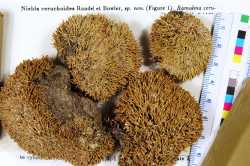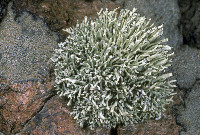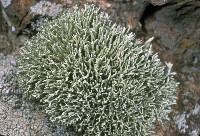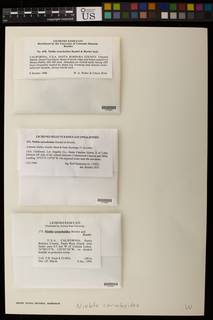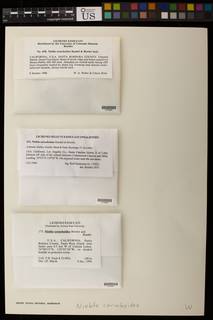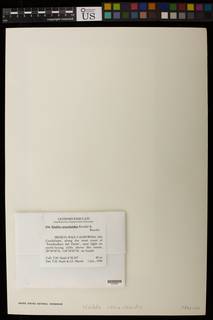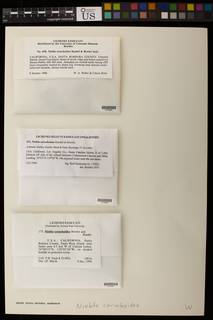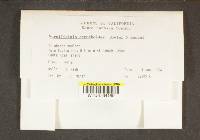
Consortium of Lichen Herbaria
- building a Global Consortium of Bryophytes and Lichens as keystones of cryptobiotic communities -
- Home
- Search
- Images
- Species Checklists
- US States: O-Z >
- US National Parks
- Central America
- South America
- US National Parks
- Southern Subpolar Region
|
|
|
|
Family: Ramalinaceae
[Desmazieria ceruchoides (H. Magn.) Follmann & Huneck, moreNiebla ceruchoides Rundel & Bowler] |
Nash, T.H., Ryan, B.D., Gries, C., Bungartz, F., (eds.) 2004. Lichen Flora of the Greater Sonoran Desert Region. Vol 2. Thallus: fruticose, dense, compact, forming bush-like mats resembling a small cushion plant or bryophyte, usually 1-3.5 cm high, less commonly larger, densely branched branches: +cylindrical, occasionally angular in some specimens, rigid and friable when dry, less than 1 mm in diam. surface: smooth or weakly faciated medulla: white, dense, lacking the strand-like hyphal adhesions Apothecia: not common, up to 7 mm wide, subterminal but near branch tips disc: pale green, concave asci: clavate, 8-spored ascospores: hyaline, 1-septate, fusiform, 10-13 x 3-4 µm Pycnidia: black, immersed, often at branch apices conidia: straight, rod-shaped, c. 3 x 1 µm Spot tests: all negative Secondary metabolites: triter-penes, zeorin, (-)-16α-hydroxykaurane, +bourgeanic acid, zeorin, usnic acid, and, fide Spjut (1996), T3 triterpene and T4 compounds (in synonymized taxa). Substrate and ecology: usually on rocks (but sometimes on soil) and cliffs on the immediate coast within the zone of coastal fog and breeze influence Sonoran distribution: occurring in widely isolated patches from San Luis Obispo County, California to the Channel Islands, and S into NW Baja California, including Cedros and Guadalupe Islands, and Baja California Sur. Notes: Niebla ceruchoides is an easily recognized species, forming characteristic tight, compressed clumps like a moss or cushion plant on ocean-facing coastal rocks, cliffs, or soil. Its branches are subcylindrical to cylindrical, usually less than 1(-1.5) mm in diam. up to 3.5(-6) mm in length. When dry the branches crack when bent. It is densely branching and the branches are often divaricate at the tips, similar to many Cladina. The thallus is yellow-green or light green in the field and becomes yellow in the herbarium. Black pycnidia occur on the attenuate branch tips, but are otherwise rare. In places on the Channel Island there is a weakly isidiate form, and the branches become slightly angular at some sites. |
|
|
|
Powered by Symbiota




